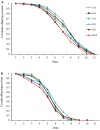Egg Allocation on Anastrepha ludens Larvae by Mass-Reared Diachasmimorpha longicaudata Females
- PMID: 41009107
- PMCID: PMC12470676
- DOI: 10.3390/insects16090926
Egg Allocation on Anastrepha ludens Larvae by Mass-Reared Diachasmimorpha longicaudata Females
Abstract
The age-dependent reproductive behavior of parasitoid females under mass-rearing conditions may influence the quality of the biocontrol agents produced. Therefore, this study assessed the egg allocation behavior of Diachasmimorpha longicaudata (Ashmead) females at different ages under mass-rearing conditions. This parasitoid native to Southeast Asia is mass-reared on irradiated Anastrepha ludens (Loew) larvae at the Moscafrut Program facility in Mexico and is released in crop areas to suppress fruit fly pest species. Parasitoid females aged 5-10 days were used to assess quality control parameters, such as parasitized host mortality, parasitoid emergence, offspring sex ratio, and superparasitism. Anastrepha ludens puparia were checked and dissected 72 h after being exposed to female parasitoids to determine the number of scars on the puparium of first-instar parasitoids, respectively. Parasitized puparia were kept under lab conditions to assess adult emergence and offspring sex ratio. Host mortality, superparasitism, and parasitoid offspring sex ratio were affected by female age. The highest host mortality and superparasitism were caused by 5-7-day-old females, which also produced a significantly higher female-to-male offspring ratio with improved fitness-related parameters. The use of cages with females of these ages may improve the quality parameters of parasitoids and result in higher female-to-male offspring sex ratios. Furthermore, production costs could be lowered by reducing the quantity of hosts and rearing commodities. These findings are a useful contribution to improving the current method used for the mass rearing of D. longicaudata at the Moscafrut Program facility.
Keywords: female allocation; fruit fly parasitoid; offspring fitness; parasitoid mass production; quality control parameters; reproductive strategy.
Conflict of interest statement
The authors declare no conflicts of interest.
Figures




References
-
- Heimpel G.E., Rosehnheim J.A., Mangel M. Egg limitation, host quality, and dynamic behavior by a parasitoid in the field. Ecology. 1996;77:2410–2420. doi: 10.2307/2265742. - DOI
-
- Lebreton S., Chevrier C., Darrouzet E. Sex allocation strategies in response to conspecifics’ offspring sex ratio in solitary parasitoids. Behav. Ecol. 2010;21:107–112. doi: 10.1093/beheco/arp156. - DOI
-
- Ueno T. Age-dependent constraints of sex allocation in a parasitoid wasp. Psyche. 2014;1:363174. doi: 10.1155/2014/363174. - DOI
LinkOut - more resources
Full Text Sources
Miscellaneous

